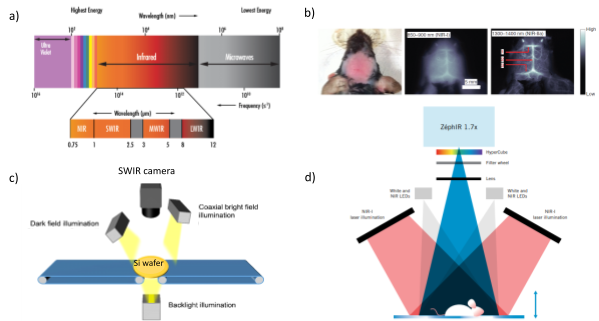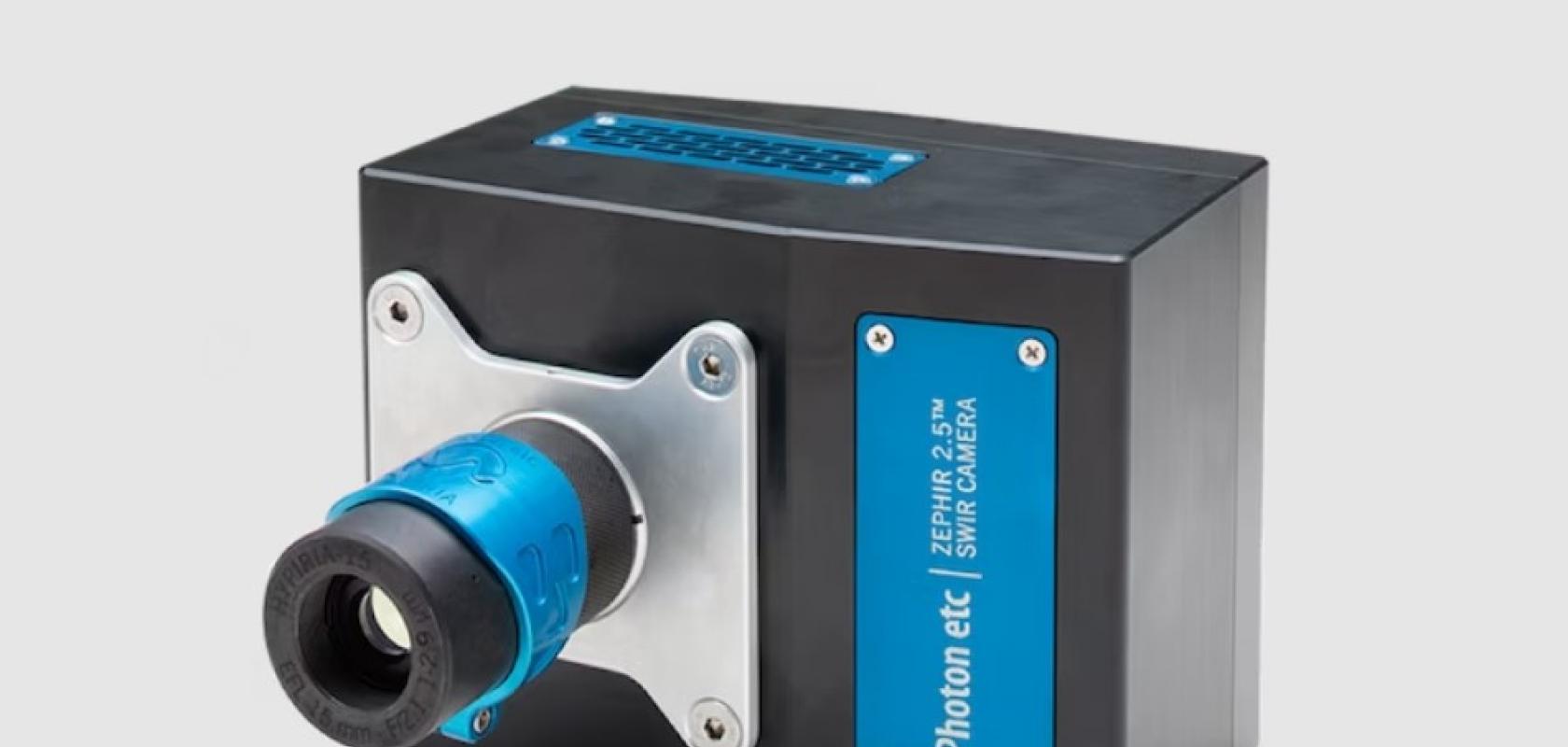Shortwave infrared (SWIR) light is electromagnetic radiation that is invisible to the naked eye. Covering the wavelength range 900-2,500nm of the electromagnetic spectrum [1,2,3], SWIR can see the invisible.
Mid- and long-wave infrared (MWIR/LWIR) radiation is able to detect emissions from objects that radiate heat. This makes it possible for thermographic cameras to produce images based on temperature variations [2]. Unlike MWIR and LWIR, SWIR behaves similarly to visible light.
This means that an object reflects or absorbs photons, rather than emitting them. This is exactly what we need to produce strong contrast and high-resolution images [2,3]. By accessing invisible bandwidths in both conventional optics and MWIR/LWIR imaging, SWIR cameras can turn the invisible visible – improving countless applications in the industrial and scientific markets.
Bioimaging equipment plays a vital role in diagnosing health conditions at early stages. This has allowed many to act on their diagnoses – either through medical or surgical treatments – make a full recovery, and, in some cases, even save lives. Deep-tissue imaging techniques, such as CT scans and X-rays, have relied on, and continue to rely on, ionising radiation (X- or gamma-rays) for rapid deep penetration and high contrast [1]. Yet, exposing biological tissue to ionising radiation poses a long-term risk of causing cancer [1].
Today, we remain dependent on ionising radiation every time we get a dental X-ray or a chest CT scan. But are the risks involved actually worth it? This is precisely why we prefer to use low-energy photons. But this poses another challenge when it comes to deep-tissue penetration due to the strong absorption and scattering of visible light from tissue components [1]. Hence the search for novel, less risky, and SWIR bioimaging techniques that allow for deeper penetration and offer high resolution and contrast.
Almost all electronic devices incorporate integrated circuits (ICs) and silicon wafers. As a result, we continue to seek faster, higher-resolution imaging solutions for chip and wafer inspections [5]. This has made the semiconductor industry one of the largest and fastest-growing sectors [4].

Figure 1: Electromagnetic spectrum depicting the NIR, SWIR, MWIR, and LWIR spectral regions, b) SWIR bioimaging showing high contrast and resolution fluorescent images of a mouse brain, clearly highlighting the strengths of SWIR over NIR imaging, c) Silicon wafer inspection process using advanced SWIR imaging techniques, d) Photon etc’s IN VIVO Hyperspectral imager using an integrated SWIR ZephIR camera for in-vivo imaging of a mouse. These figures were taken from [3], [5], [1] and [7] respectively
Most semiconductor devices are silicon-based, so silicon-wafer inspection has been of paramount importance for producing high-quality wafers. This is exactly where state-of-the-art SWIR cameras come to the rescue. Silicon is strongly opaque to visible light, but highly transmissive in the SWIR wavelength range.
The main component of a SWIR camera is an indium-gallium-arsenide (InGaAs) sensor, which is highly sensitive to the SWIR spectral window between 900 and 1,700nm. SWIR cameras, therefore, can image through silicon layers, rendering them transparent at wavelengths greater than 1,050nm [4,5]. This transparency means we can now inspect the wafer fabrication processes with non-destructive methods. SWIR light illumination promises to detect even the smallest of defects or impurities [4,5].
It is very common to introduce contaminant particles by accident during wafer manufacturing processes, especially at the top and bottom. However, with the ability to extend beyond the visible, SWIR now enables the detection of contaminant particles even in between or inside silicon wafer layers. This game changer for quality control has eliminated unwanted impurities and improved device performance [5].
The truth is, SWIR cameras have been around for a while. Significant progress is being made in the quality and sensitivity of InGaAs sensors, resolution, reduced pixel pitch, increased frame rates, more compactness, and better cooling mechanisms for extended exposure times [6]. Such improvements have enabled SWIR cameras to operate 24/7 on production lines and be more easily integrated within scientific instrumentation.
Photon etc’s ZephIR SWIR cameras (pictured) offer all these features with wavelength range options spanning 850-2,500nm, with an option to extend to 2,900nm. Their compact size and high frame rates make them ideal for demanding industrial applications and ready to integrate within scientific instrumentation. Photon etc’s hyperspectral preclinical imager, IR VIVO, takes advantage of their integrated ZephIR SWIR camera to produce high-resolution deep-tissue imaging. ZephIR cameras have been successfully used in solar cell inspections, wafer inspections, preclinical research, and bioimaging solutions.
References
[1] Thimsen, Elijah, Bryce Sadtler, and Mikhail Y. Berezin. “Shortwave-infrared (SWIR) emitters for biological imaging: a review of challenges and opportunities.” Nanophotonics 6.5 (2017): 1043-1054.
[2] https://photonicscience.com/what-is-swir-imaging/
[3] www.edmundoptics.co.uk/knowledge-center/application-notes/imaging/what-is-swir/
[4] Hashagen, Jens. “Seeing Beyond the Visible: Short-wave infrared (SWIR) cameras offer new application fields in machine vision.” Optik & Photonik 10.3 (2015): 34-37
[5] “The latest SWIR tech for inspecting semiconductor wafers” Imaging and Machine Vision Europe
[6] Mark Donaghy, “Silicon inspection uses next-generation SWIR cameras” Laser Focus World 24.2 (2021)
[7] “Hyperspectral Preclinical Imager” Photon etc
Further information
SWIR is here to take you beyond the visible. For more information on Photon etc’s SWIR solutions, please contact Photonic Solutions at: sales@photonicsolutions.co.uk


